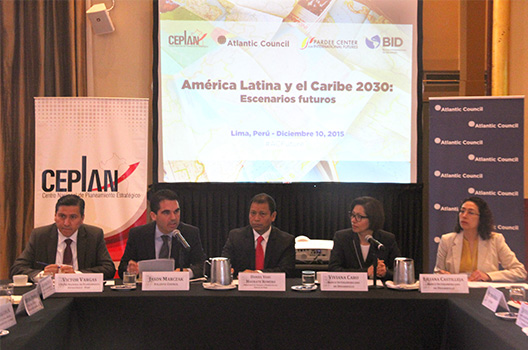 On December 10, the Atlantic Council – in collaboration with the Inter-American Development Bank (IDB) – hosted the first regional roundtable on “Latin America and the Caribbean 2030: Scenarios for the Future” in Lima, Peru. Led by Jason Marczak, Deputy Director of the Latin America Center, and Peter Engelke, Senior Fellow at the Strategic Foresight Initiative (SFI) within the Atlantic Council’s Brent Scowcroft Center, the private roundtable brought together thirty of the Andean region’s top thought leaders on national, regional, and global trends. The meeting helped distill the emerging trends and uncertainties that will most likely shape the region over the next fifteen years, and the policy interventions that might shape alternative futures or scenarios.
On December 10, the Atlantic Council – in collaboration with the Inter-American Development Bank (IDB) – hosted the first regional roundtable on “Latin America and the Caribbean 2030: Scenarios for the Future” in Lima, Peru. Led by Jason Marczak, Deputy Director of the Latin America Center, and Peter Engelke, Senior Fellow at the Strategic Foresight Initiative (SFI) within the Atlantic Council’s Brent Scowcroft Center, the private roundtable brought together thirty of the Andean region’s top thought leaders on national, regional, and global trends. The meeting helped distill the emerging trends and uncertainties that will most likely shape the region over the next fifteen years, and the policy interventions that might shape alternative futures or scenarios.
The Peru roundtable is a part of a one-year project on the future of Latin America and the Caribbean led by the Atlantic Council’s Adrienne Arsht Latin America Center and Strategic Foresight Initiative (SFI), in collaboration with the IDB. The project is based on the recognition that policymakers must often focus their attention on crises, overwhelming foresight in strategic planning and policy with the crush of events.
The event featured keynote remarks by Minister of Labor of Peru, Daniel Ysau Maurate Romero, who stressed the importance of the dialogue and of bringing “technical experts together to help gather best practices.” According to the Minister, “Latin America and the Caribbean need to stop relying on primary exports and start investing in innovation and technology.” “It is fundamental to invest in human capital in order to achieve sustainable development.” He also expressed concern for youth unemployment.
Following Minister Maurate, the potential impact of the initiative was highlighted by Viviana Caro, IDB Country Representative in Peru, and Victor Vargas, President of CEPLAN – the national planning agency of Peru and the Atlantic Council’s local partner for the roundtable. Finally, Barry Hughes, Director of the Pardee Center and Creator of the International Futures Model (IFs) being used for the Atlantic Council’s quantitative forecasting, gave some initial visions of Latin America and the Caribbean in 2030 to kick off the conversation.
Participants from Venezuela, Colombia, Ecuador, Peru, and Bolivia had a vigorous discussion about their visions for the future. Cecilia Lopez, former Senator of Colombia, noted that Latin America is in a crucial moment of transition, “where unique recipes, such as the macroeconomics of populism, have vanished as they are doomed unsustainable.” “Oftentimes, politicians are forced to worry about the next elections rather than the next generation.” Lopez sees the prospects of the future through a gender lens. “Women are forced to stay back home without any possibility to enter the economy,” she said. “Feminine discourse is strong, but public discourse is far from reaching gender equality, because people in the government seats – who are mainly men – are not interested.” As a result, “the violence [against woman] is terrible, and adolescent abortions and maternal mortality remain serious issues to tackle in Latin America.”
“We must prepare to overcome the key trends towards the future, such as demographic changes, climate change, or food security,” added Jordy Vilchez, Director of the Peruvian Government Futures Agency. “Latin America experienced a steady growth until recent years, mainly due to Chinese demand, but this has come to a halt and we are now experiencing a crisis in productivity.” In tackling this immense challenge, “the role of strategic foresight – which has allowed for private sector growth in the region – needs to be strengthened,” asserted Vilchez.
Speaking about her excitement for the project, Caterina Tuci, participant from the National Secretariat of Higher Education in Ecuador, affirmed “politicians are incentivized when they see neutral projects.” “When you present policy-makers with multiple apolitical solutions, with a technical consultancy focus, it creates a trustworthy environment and viable options that they are likely to pursue.” In her experience with the education system in Ecuador, Tuci affirms that Ecuador’s investment in education is higher than any other country in the world. “Results will not be seen today – these are long term investments – and it is not a typical behavior of a Latin American country. These are Ecuadorian best practices that other countries should be replicating,” said Tuci.
The culmination of the Futures project will be a publication in the summer of 2016 that will map out the trends shaping the region’s future and will develop alternative scenarios and recommendations to the year 2030. Expert consultations in Washington, DC and in-region; ambassadorial roundtables in Washington, DC; and two regional roundtables in Peru and Brazil – as well as smaller working groups in San Salvador, El Salvador, and Mexico City, Mexico – will help inform the publication. The Peruvian chapter is a story of success. The road to Brazil, our second regional Futures roundtable, is very promising. Stay tuned for exciting news about the future of Latin American and the Caribbean in 2030.
